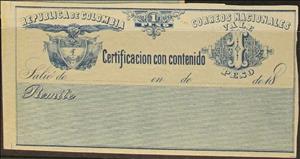Stamp: Coat of Arms, Face value (Colombia 1890)
Coat of Arms, Face value (Colombia 1890)
01 January (Colombia ) within release Insured Letter Stamps goes into circulation Stamp Coat of Arms, Face value face value 1 Colombian peso
| Stamp Coat of Arms, Face value in catalogues | |
|---|---|
| Michel: | Mi: CO-WB 18 |
| Yvert et Tellier: | Yt: CO-VR 17 |
Stamp is square format.
Inscribed REPUBLICA DE COLOMBIA. "Certificación con contenido" between arms and value. Wings of condor totally spreaded out.Also in the issue Insured Letter Stamps:
- Stamp - Coat of Arms in center, Face value on it´s right face value 20;
- Stamp - Coat of Arms, Face value face value 30;
- Stamp - Coat of Arms in center, Face value on it´s right face value 30;
- Stamp - Coat of Arms, Face value face value 40;
- Stamp - Coat of Arms in center, Face value on it´s right face value 80;
- Stamp - Coat of Arms, Face value face value 70;
- Stamp - Coat of Arms in center, Face value on it´s right face value 10;
- Stamp - Coat of Arms, Face value face value 20;
- Stamp - Coat of Arms, Face value face value 80;
- Stamp - Coat of Arms in center, Face value on it´s right face value 50;
- Stamp - Coat of Arms, Face value face value 90;
- Stamp - Coat of Arms, Face value face value 50;
- Stamp - Coat of Arms in center, Face value on it´s right face value 70;
- Stamp - Coat of Arms in center, Face value on it´s right face value 1;
- Stamp - Coat of Arms, Face value face value 1;
- Stamp - Coat of Arms in center, Face value on it´s right face value 60;
- Stamp - Coat of Arms, Face value face value 60;
- Stamp - Coat of Arms, Face value face value 10;
- Stamp - Coat of Arms in center, Face value on it´s right face value 90;
- Stamp - Coat of Arms in center, Face value on it´s right face value 40;
Stamp Coat of Arms, Face value it reflects the thematic directions:
A coat of arms is an heraldic visual design on an escutcheon (i.e. shield), surcoat, or tabard. The coat of arms on an escutcheon forms the central element of the full heraldic achievement which in its whole consists of shield, supporters, crest, and motto. A coat of arms is traditionally unique to an individual person, family (except in the United Kingdom), state, organisation or corporation.
A number is a mathematical object used to count, measure, and label. The most basic examples are the natural numbers 1, 2, 3, 4, and so forth. Numbers can be represented in language with number words. More universally, individual numbers can be represented by symbols, called numerals; for example, "5" is a numeral that represents the number five. As only a relatively small number of symbols can be memorized, basic numerals are commonly organized in a numeral system, which is an organized way to represent any number. The most common numeral system is the Hindu–Arabic numeral system, which allows for the representation of any non-negative integer using a combination of ten fundamental numeric symbols, called digits. In addition to their use in counting and measuring, numerals are often used for labels (as with telephone numbers), for ordering (as with serial numbers), and for codes (as with ISBNs). In common usage, a numeral is not clearly distinguished from the number that it represents.
A vulture is a bird of prey that scavenges on carrion. There are 23 extant species of vulture (including condors). Old World vultures include 16 living species native to Europe, Africa, and Asia; New World vultures are restricted to North and South America and consist of seven identified species, all belonging to the Cathartidae family. A particular characteristic of many vultures is a bald, unfeathered head. This bare skin is thought to keep the head clean when feeding, and also plays an important role in thermoregulation



